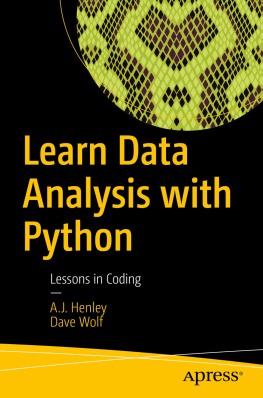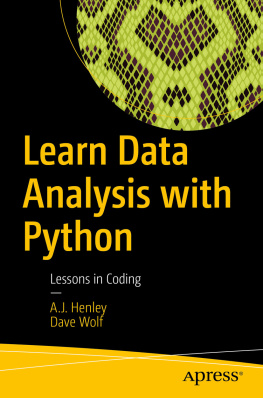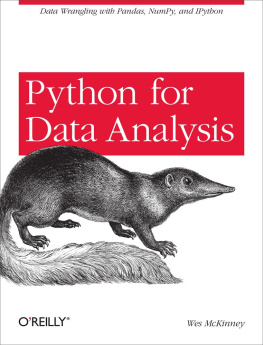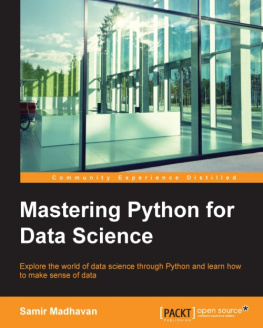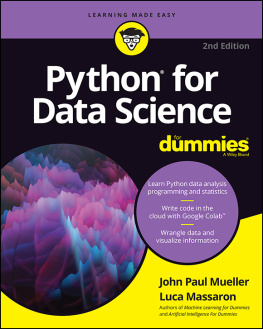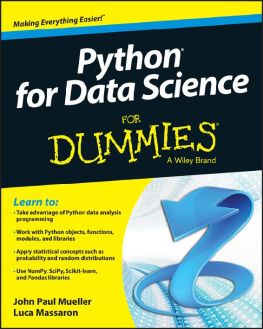Python for Data Analysis
A Complete Guide for Beginners, Including Python Statistics and Big Data Analysis
Copyright 2019 - All rights reserved.
The content contained within this book may not be reproduced, duplicated or transmitted without direct written permission from the author or the publisher.
Under no circumstances will any blame or legal responsibility be held against the publisher, or author, for any damages, reparation, or monetary loss due to the information contained within this book. Either directly or indirectly.
Legal Notice:
This book is copyright protected. This book is only for personal use. You cannot amend, distribute, sell, use, quote or paraphrase any part, or the content within this book, without the consent of the author or publisher.
Disclaimer Notice:
Please note the information contained within this document is for educational and entertainment purposes only. All effort has been executed to present accurate, up to date, and reliable, complete information. No warranties of any kind are declared or implied. Readers acknowledge that the author is not engaging in the rendering of legal, financial, medical or professional advice. The content within this book has been derived from various sources. Please consult a licensed professional before attempting any techniques outlined in this book.
By reading this document, the reader agrees that under no circumstances is the author responsible for any losses, direct or indirect, which are incurred as a result of the use of information contained within this document, including, but not limited to, errors, omissions, or inaccuracies.
Table of Contents
Introduction
Congratulations on purchasing Python for Data Analysis, and thank you for doing so.
The following chapters will discuss all of the things that we need to know when it is time to work on our own data analysis for the first time. Many companies have heard about data analysis and are curious to know how this works and what they are able to do with it. However, many are not sure the right steps to take in order to see the best results. This guidebook is not only going to walk you through completing your own data analysis but will ensure that you are set and able to do it all with the Python coding language as well.
This guidebook is going to look at some of the basics that you need to do in order to start with your own data analysis. This is going to ensure that you are set to start this process on your own and that you will see some of the results of better decision making, cutting down waste, beating out the competition, and reaching your customers better than ever before .
To start with this process, we spent a bit of time learning more about the data analysis and what this is all about. There are a number of steps that we need to know about in order to get started with this process, and we will talk about the basics of data analysis, some of the benefits of working with this process, and the steps or the lifecycle that works with our data analysis as well.
Once we have some time to look through data analysis and how it works, it is time for us to move into the Python language. There are a number of different coding languages that we are able to use along with our data analysis, but the Python language has some of the best libraries and the best tools to help to get this done. In addition, a language is simple and easy to use. This guidebook will take some time to discuss why the Python language is such a good choice to use when it comes to doing this data analysis and how you can get it all started.
From there, we need to spend some time on a few of the best libraries that will work for our data analysis and are connected to the Python language as well. We will start with the NumPy library, which is designed to work for most of the other libraries as well since they rely on the arrays that are found in this library. We can then move on to the Matplotlib library, the Pandas library, and some of the reasons why you would want to work with the IPython environment rather than the traditional option that is out there.
To end this guidebook, we have a few more parts that we need to spend some time on as well. We are going to look at the basics of data visualizations and why we would want to use these, some of the best tools that work so well with the Python language and some of the industries and practical applications that come with using the Python data analysis for your own business as well.
There are a ton of benefits that show up when we talk about the Python data analysis and any industry, and any business will be able to benefit when they choose to use this for their own needs as well. When you are ready to learn some more about the Python language and how it can work to improve your data analytic skills to help your business, make sure to check out this guidebook to help you get started.
Chapter 1: Introduction of Python and Pytho n s History
There are many different coding languages out there that we are able to work with. Learning how these work and what they can help us to create is such a wonderful thing in the projects that we can create. However, we need to make sure that we are learning the right coding language for our needs.
When it comes to working with data analysis and all of the different parts that come with that process, the Python language is one of the best. Sure, there are other options out there that we can choose from, but none will provide us with the ease of use, the power, the different libraries and extensions, and more, that will truly make our data analysis shine and provide us with the answers and results that we need.
With that in mind, it is time for us to take a closer look at the Python language and learn a bit more about it. We need to learn the history of the Python language and why it is one of the best out there for us to learn from. In addition, we need to look at some of the ways that we are able to use the Python language in order to get the full use out of it as well. Let us dive in and see how this can work!
The History of Python
Python is a very popular programming language that is high-level and general-purpose. It was designed in 1991 by Guido van Rossum and then developed by Python Software Foundation. It was developed in the beginning with an emphasis on having codes that were readable to all, and the syntax was made to help programmers find better ways to express the concepts that they wanted in fewer lines of code.
During the late 1980s, history was about to be written brand new. It was during this time when some of the work on the modern Python language first began. Soon after this time, Guido van Rossum began doing some of the application based work in 1989 at the Centrum Wiskunde and Informatica, which was found in the Netherlands .
Working on the Python language was just a hobby project to get started because van Rossum was just looking for something that could capture his interest during the Christmas break. The programming language, which Python is known to have succeeded, is the ABC Programming language.
ABC was something that van Rossum had worked to create earlier on in his own career, but he had seen that there were a few issues with the features and more of this language. After some time, he decided that he needed to go through and make some changes to improve it, which led him to take the syntax of the ABC language, and some of the good features that were still found in it, and make it into something new.
The inspiration that is found with the name of this language was from Monty Pythons Flying Circus since van Rossum was a big fan of this and he wanted to come up with a name that was unique, short, and maybe even a bit mysterious for the invention he was working with on Python. Van Rossum continued to work as the leader on this language until July of 2018, but he was considered a benevolent dictator who allowed other developers to work on the language with many free reigns to give us the language that we know and live today .


